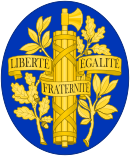Minister of the Interior (France)
| Minister of the Interior of the French Republic | |
|---|---|
| Ministre de l’Intérieur | |
| Minister of the Interior | |
| Member of | Cabinet |
| Reports to | President of the Republic Prime Minister |
| Seat | Hôtel de Beauvau, Paris 8e, France |
| Nominator | Prime Minister |
| Appointer | President of the Republic |
| Term length | No fixed term |
| Formation | 7 August 1790 |
| Website | www.interieur.gouv.fr |
 |
|---|
The Minister of the Interior (French: Ministre de l'Intérieur; French pronunciation: [ministɛʁ də lɛ̃teˈʁjœʁ]) is an important position in the Government of France. The office is equivalent to the Interior Minister of other countries, like the Home Secretary of the United Kingdom, or similar to a combination of the Attorney General and Secretary of Homeland Security in the United States.
Responsibilities
The Minister of the Interior is responsible for the following:
- The general interior security of the country, with respect to criminal acts or natural catastrophes
- including the major law-enforcement forces
- the French National Police
- the French Gendarmerie for its police operations (as a part of the French Armed Forces, the Gendarmerie is administratively under the purview of the Ministry of Defence)
- General directorate for civil defence and crisis management (Sécurité Civile)
- the directorate of Firefighters (Sapeurs-Pompiers)
- including the major law-enforcement forces
- the granting of identity documents (passports, identity cards) and driving licenses through the network of préfectures
- relations between the central government and local governments
- logistics and organization of political elections, at the national and prefectoral levels (but the results of the elections are overseen by the Constitutional Council or the administrative courts)
- regulation of immigration and preventing illegal immigration
- integration of legal immigrants (professionally, linguistically, housing)
- all départemental préfets and sub-prefects are subordinate to the Minister of the Interior
The Minister of the Interior also takes on the role of the former Ministre des cultes and is formally consulted in the process of appointment of Catholic diocesan bishops (Briand-Ceretti Agreement). The Minister of Worship used to be a fully-fledged minister, but this position no longer exists since 1912.
While the Ministry of the Interior supervises police forces, it does not supervise criminal enquiries. Those enquiries are conducted under the supervision of the judiciary.
The Ministry's headquarters are located on the place Beauvau, facing the Élysée Palace. "Place Beauvau" is often used as a metonym for the ministry. The current Minister of the Interior is Prime Minister Edouard Philippe who replaces temporarily Gérard Collomb since his resignation on october 3, 2018.


